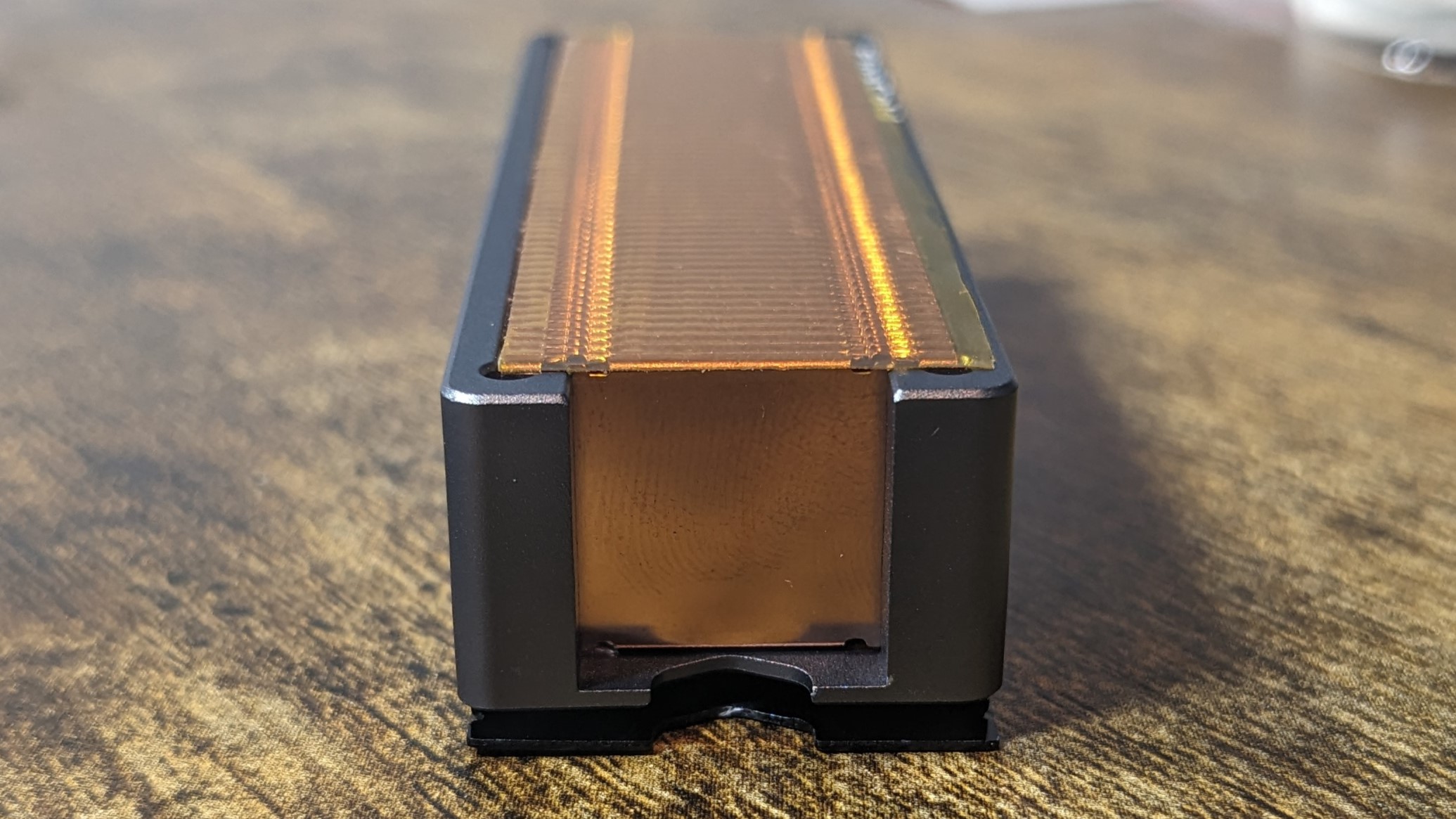Pros
- Striking all copper design
- Slim Profile means no compatibility problems
Cons
- Moderate price of $18 USD

This review will cover the Jeyi FinsCold Q150 m.2 NVMe heatsink cooler, which features an all-copper design to help keep your PCI-e 4 and 5 drives running at peak performance. Who is Jeyi? That’s a good question! I had never heard of them before I saw this unit on Amazon. I performed a few searches in an attempt to find out more about them, but I wasn’t able to find much information.
I was able to determine that they’re based out of China. Looking at AliExpress shows that they make a variety of PC peripherals most of which are storage related. Hey Jeyi, if you read this article – reach out to me so I can tell people more about your history!
EDIT:
Jeyi makes a variety of PC related products, mostly related to storage accessories – m.2 heatsinks, drive enclosures, expansion cards, SD card readers, etc. Their website is www.jeyi.com, but lacks many details about the history of the company. I’ll reach out to learn more about them.

Subscribe to Boring Text Reviews for news and CPU Cooling reviews!
Packaging
The FinsCold Q150 arrives in a small box, like most “high end” m.2 heatsinks do.

The unit is protected with a soft covering and a plastic enclosure. The top of the heatsink is protected with a plastic yellow peel tape.

Included in the box are:
- User Manual
- Small Screwdriver and screws
- Thermal pads of multiple thickness sizes
- Heatsink

Features of Jeyi’s FinsCold Q150
Multiple sizes of thermal pads – to insure a proper fit!
Most NVMe heatsinks on the market arrive with just one pair of thermal pads, but that might not result in the best fit for your SSD – especially if only parts of the bottom side are covered with NAND. Jeyi includes 3 sizes of thermal pads to insure a proper fitting to the SSD no matter what size or shape it is.

Low profile for full compatibility
Many of the newest NVMe m.2 heatsinks are tall, and some of these aren’t compatible with certain CPU air coolers as a result. The SB-HTSP Rocket has a height of less than 18mm, ensuring compatibility no matter what CPU cooler you’re using!
50 Copper Fins for heat transfer

What makes this heatsink standout from the competition is the 50 fin, all copper design of the heatsink. This gives it an asthetic flair, and in theory should move heat away from the SSD well.

Dual Sided SSD Support
Some heatsinks on the market only offer cooling for the top of a SSD, but the Jeyi FinsCold Q150 cools both top and bottom sides of a m.2 SSD.
Installation
The installation of the SSD heatsink is exactly the same as most units on the market: apply the thermal pads to the base of the unit, insert the SSD, apply thermal pads to the top of the SSD, attach the heatsink, secure it with the included screws, and then install it on your motherboard’s m.2 slot.

Testing Configuration
CPU: Intel i7-13700K
Motherboard: MSI Z690 A Pro DDR4
Computer Case: BeQuiet Silent Base 802, System fans set to low
SSD: TeamGroup T-Force Z540 PCI-e 5 SSD
Comparison Coolers:
Uncooled SSD
BeQuiet MC1 and MC1 Pro Heatsinks
Ineo M9
Ineo M12
Ineo M4
NewHail NH1
Sabrent Rocket SB-HTSP
Thermalright HR-09 Pro
Thermalright HR-10 Pro
Jeyi FinsCold Q150
Graugear G-M2HP04-F
Glotrends Heatsink
QIVYNSRY heatsink
While the SSD being used is capable of PCI-e 5 speeds, the motherboard is not. This might reduce the total potential heat output, but in my limited testing thus far PCI-e 4 hasn’t prevented testing from getting the drive hot.
Thermal Performance & Comparison Results
To test the performance of the heatsinks cooling ability, I’ve run a custom IOMeter script which takes 30 minutes to complete testing. This script is designed to cause the drive, and especially it’s controller, to create as much heat as possible. You might consider it a “Furmark” of SSD testing, it’s a power virus designed for the purpose of testing NVMe cooling.

The Jeyi FinsCold Q150 was able to keep the SSD unthrottled, enabling full performance, but it ran fairly toasty at 78C. Higher temperatures are to be expected with most low profile NVMe heatsinks, but I was hoping the all copper design would show a performance advantage over normal heatsinks with a single heatpipe like BeQuiet’s MC1 Pro.

While the reduced temperatures don’t always translate into higher benchmark performance, it will increase it’s lifespan and longevity. A SSD running at or near peak temperatures (also known as TJunction Max or TJ Max) with have a lower lifespan compared to one running at a more reasonable temperature.
Value
For heatsinks like this which are able to run a SSD unthrottled, a great way to look at it’s value is to compare the thermal improvement for every dollar spent.
At first glance you would think that Jeyi’s Q150 offers bad value – but keep in mind only that many low profile heatsinks won’t pass my tests without throttling. Of those I’ve tested, only 4 made the “value” list by being able to run the SSD unthrottled.

Conclusion
Subscribe to Boring Text Reviews for news and CPU Cooling reviews!
Jeyi’s FinsCold Q150’s all copper design offers a nice aesthetic flair and offers basic cooling performance capable of sustaining a NVMe m.2 SSD’s peak performance, and it’s low profile design means you won’t run into any compatibility issues using it. If you’re interested in this product, it’s typically available for $17.90 on Amazon.com

